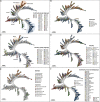Whole-Genome-Based Helicobacter pylori Geographic Surveillance: A Visualized and Expandable Webtool
- PMID: 34408729
- PMCID: PMC8366602
- DOI: 10.3389/fmicb.2021.687259
Whole-Genome-Based Helicobacter pylori Geographic Surveillance: A Visualized and Expandable Webtool
Abstract
Helicobacter pylori exhibit specific geographic distributions that are related to clinical outcomes. Despite the high infection rate of H. pylori throughout the world, the genetic epidemiology surveillance of H. pylori still needs to be improved. This study used the single nucleotide polymorphisms (SNPs) profiling approach based on whole genome sequencing (WGS) to facilitate genomic population analyses of H. pylori and encourage the dissemination of microbial genotyping strategies worldwide. A total number of 1,211 public H. pylori genomes were downloaded and used to construct the typing tool, named HpTT (H. pylori Typing Tool). Combined with the metadata, we developed two levels of genomic typing, including a continent-scale and a country scale that nested in the continent scale. Results showed that Asia was the largest isolate source in our dataset, while isolates from Europe and Oceania were comparatively more widespread. More specifically, Switzerland and Australia are the main sources of widespread isolates in their corresponding continents. To integrate all the typing information and enable researchers to compare their dataset against the existing global database easily and rapidly, a user-friendly website (https://db.cngb.org/HPTT/) was developed with both genomic typing tools and visualization tools. To further confirm the validity of the website, ten newly assembled genomes were downloaded and tested precisely located on the branch as we expected. In summary, the H. pylori typing tool (HpTT) is a novel genomic epidemiological tool that can achieve high-resolution analysis of genomic typing and visualizing simultaneously, providing insights into the genetic population structure, evolution analysis, and epidemiological surveillance of H. pylori.
Keywords: Helicobacter pylori; antibiotic-resistant; genomic; genotyping; phylogenetic; webtool; whole-genome sequencing.
Copyright © 2021 Jiang, Xu, Zhang, Li, Li and Tan.
Conflict of interest statement
The authors declare that the research was conducted in the absence of any commercial or financial relationships that could be construed as a potential conflict of interest.
Figures




References
LinkOut - more resources
Full Text Sources
Miscellaneous

